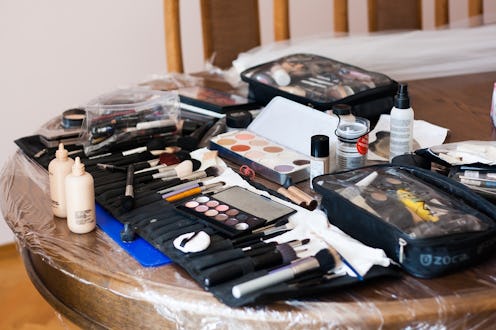Fashion
7 Beauty Products That May Be Harming Your Health

If you hear someone refer to, the is a "dark side" of the beauty industry, you might let out a little giggle —because, really, how can kitten nail decals and sparkly false eyelashes really be that scary? But try searching a few ingredients in your favorite drugstore face wash for fun one day, and you might get a little spooked. Just because it says "organic" and smells like green tea doesn't mean it's necessarily good for you. Everyone makes mistakes with their beauty regime (remember the kitten nail decals and sparkly false eyelashes we just talked about?), but that doesn't mean you should risk health for the sake of a trendy look.
Whether you're a seasoned beauty fanatic with a stocked make up drawer or a newcomer to the makeup game, it is important to be aware of what you should and shouldn't put on your body. Because whether or not you like it, your skin absorbs some of what you expose it to — and nobody wants to put deadly chemicals in their blood stream. Take this opportunity to make a clean out your beauty cabinet, because the only thing better than an organized bathroom is a top shelf full of safe-to-use products.
1. Products containing isopropyl alcohol, AKA rubbing alcohol
OK — no, not THAT type of alcohol. But you may be surprised to learn that rubbing alcohol is found in plenty of beauty products, from skincare to eyeshadow — and it's really not the best thing for your skin. Isopropyl alcohol strips your skin of its natural immune barrier and moisture, and helps other harmful chemicals to penetrate your skin. Overall, it's bad news for your skin health. The more visible effects include the promotion of brown spots and premature aging.
2. Certain color pigments
Everyone loves a colorful lip or shadow once in a while, but you have to be careful with exactly what's in that vibrant hue. FD&C (Federal Food, Drug and Cosmetic Act) pigments are those that have been approved for sale in the US, but might still be dangerous to use. They're made from coal tar and contain loads of toxic heavy metal salts, which can be absorbed into the skin and deplete your body of oxygen —meaning low energy levels, just because of a tube of lipstick. Clinical trials also show that almost all FD&C pigments are carcinogenic, with symptoms including brain tumors, testes tumors, organ damage, birth defects, nerve cell damage, and hyperactivity, among others.
3. Products that have gone bad
You know that mint face mask you were obsessed with in high school? If you are still using the same bottle you literally bought sophomore year, it's time to toss it. You'd be surprised how many of the products you need to get rid of in that makeup bag. The second you open a product is when the ingredients might start to oxidize and humidity begins to promote mold and yeast growth — not something you want on your face or in your cabinet. Believe it or not, liquid eyeliner and mascara are only good for three months.
4. Petroleum jelly and mineral oil
An ingredient with "mineral" in the name might sound super organic, but it actually poses a few scary skin dilemmas. Mineral oil and petroleum jelly both cannot be metabolized, or broken down, meaning they just sit in your system — and both might be carcinogenic. Petroleum is in 82 percent of hair dyes, 45 percent of self-tanners and 36 percent of facial moisturizers, so keep an eye out for this potentially cancerous ingredient.
5. Sunscreen chemicals
It might seem simple: putting on sunscreen is good for your health — because, duh, skin cancer and skin damage. But it turns out picking the right sunscreen is a lot more complicated than a trip to the drug store. Many chemicals found in typical sunscreens have been discovered to disrupt hormone levels, prove toxic to reproductive systems, and interfere with child development. Seriously, your sunscreen. Two European studies have found sunscreen chemicals in pregnant mothers' milk, which likely means the baby is being exposed to those toxins early on. What's the best way to know what you're putting on your body? Check out the Environment Working Group's list of best—and safest—sunscreens.
6. Perfume or fragrance
Believe it or not, but when you see "perfume" or "fragrance" on the list of ingredients for a beauty product, it could be one of about 3,000 chemicals that are considered fragrances, most of which have not been tested for toxicity (especially when used together). Many of them are capable of triggering allergies or asthma, while others have been linked to neurotoxicity and cancer. Hardly worth the fancy smell! Keep an eye on the ingredient of a perspective perfume, and if you aren't entirely sure if it's safe, skip it!
7. Hair straightening products
It might be a good idea to invest in a good flat iron instead of a heavy duty straightening treatment. Back in 2013 it was discovered that a Brazilian Hair Smoothing Solution contained 12 percent formaldehyde (notorious in the beauty world for causing cancer), while other hair products tend to contain only 0.1 percent. There is also concern that formaldehyde can cause your hair cuticles permanent damage, so if you're looking for a sleeker look, do your research before investing in a serious treatment that just might do more harm than cuteness.
Images: Kaboompics_com/Pixabay, Giphy (7)